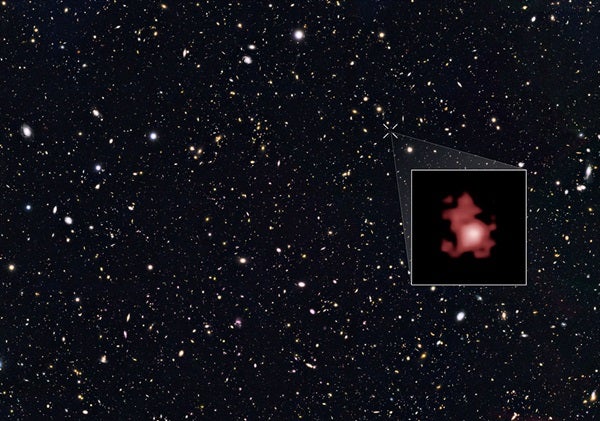The remote galaxy GN-z11, shown in the inset, existed only 400 million years after the Big Bang when the universe was only 3 percent of its current age. It belongs to the first generation of galaxies in the universe, and its discovery provides new insights into the early universe. This is the first time that the distance of an object so far away has been measured from its spectrum, which makes the measurement extremely reliable.
GN-z11 is actually ablaze with bright young blue stars, but these look red in this image because its light was stretched to longer, redder wavelengths by the expansion of the universe.
Using the NASA/ESA Hubble Space Telescope, an international team of astronomers has measured the distance to this new galaxy, named GN-z11. Although extremely faint, the galaxy is unusually bright considering its distance from Earth. The distance measurement of GN-z11 provides additional strong evidence that other unusually bright galaxies found in earlier Hubble images are really at extraordinary distances, showing that we are closing in on the first galaxies that formed in the universe.
Previously, astronomers had estimated GN-z11’s distance by analyzing its color in images taken with both Hubble and the NASA Spitzer Space Telescope. Now, for the first time for a galaxy at such an extreme distance, the team has used Hubble’s Wide Field Camera 3 (WFC3) to precisely measure the distance to GN-z11 spectroscopically by splitting the light into its component colors.
“Our spectroscopic observations reveal the galaxy to be even further away than we had originally thought, right at the distance limit of what Hubble can observe,” said Gabriel Brammer of the Space Telescope Science Institute.
This puts GN-z11 at a distance that was once thought only to be reachable with the upcoming NASA/ESA/CSA James Webb Space Telescope (JWST).
“We’ve taken a major step back in time, beyond what we’d ever expected to be able to do with Hubble. We managed to look back in time to measure the distance to a galaxy when the universe was only three percent of its current age,” said Pascal Oesch of Yale University in New Haven, Connecticut.
To determine large distances, like the one to GN-z11, astronomers measure the redshift of the observed object. This phenomenon is a result of the expansion of the universe. Every distant object in the universe appears to be receding from us, and as a result, its light is stretched to longer, redder wavelengths.
Before astronomers determined the distance to GN-z11, the most distant measured galaxy, EGSY8p7, had a redshift of 8.68. Now, the team has confirmed GN-z11’s distance to be at a redshift of 11.1, which corresponds to 400 million years after the Big Bang.
“The previous record-holder was seen in the middle of the epoch when starlight from primordial galaxies was beginning to heat and lift a fog of cold hydrogen gas,” said Rychard Bouwens from the University of Leiden in the Netherlands. “This transitional period is known as the reionization era. GN-z11 is observed 150 million years earlier, near the very beginning of this transition in the evolution of the universe.”
The combination of observations taken by Hubble and Spitzer revealed that the infant galaxy is 25 times smaller than the Milky Way and has just one percent of our galaxy’s mass in stars. However, the number of stars in the newborn GN-z11 is growing fast: The galaxy is forming stars at a rate about 20 times greater than the Milky Way does today. This high star formation rate makes the remote galaxy bright enough for Hubble to see and to perform detailed observations.
However, the discovery also raises many new questions as the existence of such a bright and large galaxy is not predicted by theory. “It’s amazing that a galaxy so massive existed only 200 million to 300 million years after the very first stars started to form. It takes really fast growth, producing stars at a huge rate, to have formed a galaxy that is a billion solar masses so soon,” said Garth Illingworth of the University of California in Santa Cruz.
Marijn Franx, a member of the team from the University of Leiden said, “The discovery of GN-z11 was a great surprise to us as our earlier work had suggested that such bright galaxies should not exist so early in the universe.” His colleague Ivo Labbe added: “The discovery of GN-z11 showed us that our knowledge about the early universe is still restricted. How GN-z11 was created remains somewhat of a mystery for now. Probably we are seeing the first generations of stars forming around black holes?”
These findings provide a tantalizing preview of the observations that the James Webb Space Telescope will perform. “This new discovery shows that JWST will surely find many such young galaxies reaching back to when the first galaxies were forming,” concluded Illingworth.
It only became visible for Hubble because of its high star formation rate, which causes the galaxy to be unusually bright for its distance. // Credit: NASA/ESA/G. Bacon (STScI)










